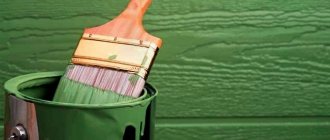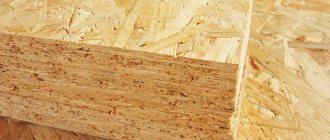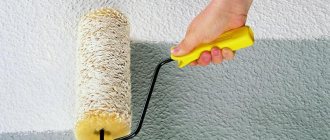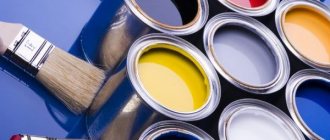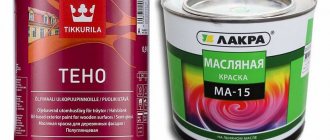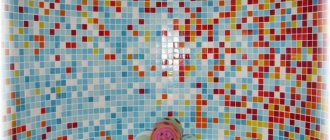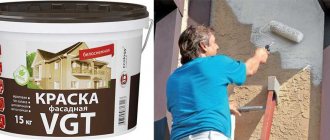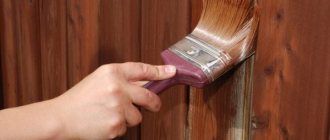Combination of enamel and acrylic paint
Painted surfaces often have to be renewed, regardless of whether the finishing work was carried out efficiently and correctly.
But first of all, you need to decide what paint can be used for external and internal finishing work. First, you need to remove the old layer of material. This is done by several methods:
- Clean off the previous coating with sharp tools or a drill with a specific attachment;
- Heated with a hairdryer for construction, this softens the previous paint, and the paint coating is easily removed;
- Wash off with various special solvents.
But this is a slow and expensive process, so most people doing renovations prefer to paint the surface over the old coating.
In our article we will look at the main types of coating and whether enamel can be applied on top of acrylic paints.
The difference between enamel and acrylic paint in composition and technical characteristics
The most common types of materials used in repairs are acrylic and alkyd, which are more advanced types of oil-based enamels.
Although they are often confused, they differ radically in composition:
- Alkyd. Compared to enamels, these paints dry faster and form a protective film on the surface. It contains polyhydric alcohols, for example, glycerin and orthophthalic acid;
- Acrylic. They are produced on the basis of plexiglass, with the addition of components that improve the properties of oil paints.
According to technical characteristics, the following differences can be distinguished between enamels and acrylic paints:
- Acrylic coating has a significantly longer service life compared to oil-based or water-based enamels. Exposure to oxygen and ultraviolet rays significantly affect the surface of the paintwork;
- When applied, acrylic is more resistant to sunlight and is not as susceptible to fading and yellowing;
- Alkyd film, due to the rapid formation of a protective film, dries in a short time, within a couple of days, while the acrylic surface will reach its ideal strength only after a month;
- But the long drying process makes the acrylic coating much stronger than alkyd, protecting the surface from scratches and deformations;
- Alkyd paints have a brighter and more varied range of colors.
Main components
All painting materials can be divided according to their constituent solvents and astringent properties:
- There are main types of substances that determine viscosity and main qualitative features: latex, epoxy, acrylic, oil;
- Both thinners are used, which only reduce the viscosity, and solvents, in addition making the coating less fluid;
- What additives are used for greater efficiency;
- Paints that have the properties of getting rid of mold and preventing corrosion.
Let's look at the main types of painting substances and their differences.
Oil and enamel compositions
They are used when applied to metal, wood and plaster.
Important! After use they have no toxic emissions and are resistant to light and liquids.
- Oily substances are made from drying oil. Gasoline, white spirit or turpentine are added for dilution. The cost is low, which attracts users, but they take a long time to dry and after some time acquire a yellowish tint;
They are used when applied to metal, wood and plaster.
Important! After use they have no toxic emissions and are resistant to light and liquids.
- A special varnish is added to paint coatings that contain enamel, which makes the surfaces smoother and more attractive.
Enamels are also impervious to light and moisture, protect the repair site from corrosion, and are used on metal, concrete, wood and plaster.
Emulsion and dispersion materials
These coatings are diluted with water, but the unique properties do not allow substances to dissolve in it, forming a viscous emulsion.
Such materials adhere well to various substrates, dry in a short period of time, do not have an unpleasant odor, and burn poorly.
Most people assume that these materials have the same properties, but this is not the case.
- Emulsions are susceptible to washing off, so dispersion paints and varnishes are used in damp rooms;
- Water emulsions have a large selection of colors and shades;
- Compositions based on aqueous dispersion cannot be used at low subzero temperatures.
Attention! In terms of their properties, the leading positions among these types of paints are occupied by materials based on acrylic surfaces, resins and polymers, which add strength and elasticity.
What is alkyd paint?
Alkyd automotive enamel is a derivative of oily alkyd resin. The alkyd type can be called a more modernized version of oil paints. They are characterized by a similar mechanism of hardening and formation of a surface film (which, by the way, is somewhat stronger, but less elastic). Alkyd paints consist of polyhydric alcohols (for example, glycerin) in combination with orthophthalic acid. Actually, the word “alkyd” comes from a combination of the words “alcohol” (alcohol) and “acid” (acid). Alkyd paint for cars has been used for painting for decades and has managed to prove its positive qualities. It is used to give an updated look to the body due to the ease of application to the surface and the wide variety of color shades in the palette. It polymerizes quickly and does not require several layers, but requires careful surface treatment before painting.
Do not forget that rapid setting leads to the formation of a thin film, which, under all environmental conditions, does not allow the entire applied layer to dry quickly and evenly in depth, so special hardeners are now added to the car paint composition. Alkyd paint for metal protects the surface from aggressive external influences and, as a result, from corrosive processes, but it is short-lived. The big advantage of this type of coating is its low cost. To completely paint a car, such enamel is used very rarely, as it requires additional varnish and polishing. There is also a completely matte automotive enamel; it is used either for local repairs before varnishing, or as an independent decoration for parts on which shine is not needed.
What is acrylic paint?
Acrylic enamel is the most popular type of paint among car owners. Automotive acrylic enamel consists of two components: a coloring pigment and a hardener. Unlike alkyd paints, acrylic paints are made on the basis of acrylic, a polymer better known as plexiglass. Paints may contain various additional components designed to improve certain properties (add elasticity, speed up drying). Unlike alkyd paint, the surface of acrylic paint retains its original appearance much longer. The enamel can be either glossy or matte.
- High reflective characteristics of the painted surface;
- Short period of time from application to complete drying;
- Resistance to mechanical stress;
- Low shrinkage when painting.
Basic properties
- Life time. Unlike alkyd paint, the surface of acrylic paint retains its original appearance much longer. It is advisable to renew alkyd paint about once a year, since oxygen and ultraviolet radiation intensively destroy the surface layer of paint. Acrylic coating, subject to surface preparation and paint application technology, can last for years.
- UV resistance. Acrylic practically does not change the properties of the surface film under the influence of sunlight, that is, it does not fade, does not turn yellow and does not acquire a “matte” appearance (it also changes). Alkyd compositions are not so reliable in this regard.
- Drying process. Alkyd film dries relatively quickly, and after just a couple of days it fully performs its protective and decorative functions. The acrylic film completes its formation approximately a month after application to the surface. In this case, the coating should be protected from mechanical influences until it is completely dry.
- Mechanical stability. The longer process of forming an acrylic film is compensated by a higher level of resistance to mechanical stress (deformation, scratches).
- Decorative properties. Alkyd compositions are distinguished by a more diverse range of shades and halftones, as well as generally brighter colors. On the other hand, acrylic paint lasts longer and does not require regular updating.
The moral of this story is that tractors and tanks and all sorts of pieces of iron can be painted with any of these paints)))) But to paint our personal cars we use only acrylic paints.
About paint compatibility
Many people wonder whether it is possible to apply acrylic paint on top of oil paint, and vice versa, enamel on an acrylic base?
Attention! To begin with, it is recommended to coat the surface with epoxy putty.
- It is advisable to apply acrylic paint only to a similar coating;
- You cannot use alkyd and epoxy resins to paint past glossy and varnished bases;
- Any coating can be applied to dispersion and emulsion materials.
Why you can’t paint with acrylic paint over enamel
Let us conditionally define that the term “enamel” means all paint and varnish materials that, as a result of painting, give a glossy, stable surface. This includes both oil paints and pentaphthalic paints (PF). At first glance, water-dispersed compositions, including acrylic ones, should not fit well onto a glossy coating. This is partly a true statement. However, it is quite possible to paint a smooth painted surface with an acrylic compound. Let's look into this issue.
What paint goes on enamel
Acrylic and oil paints are used to paint both the exterior and interior of a building. Situations often arise when you need to paint with acrylic a surface on which there is a layer of old oil paint. Is it possible to combine these two completely different colors? To answer this question, it is necessary to understand in more detail the properties of both types of paint and varnish compositions.
Advantages of acrylic compositions
Acrylic paints have long and firmly conquered the construction market for several reasons:
- The compositions do not have an unpleasant odor, are harmless to use and environmentally friendly to use;
- The ability to select the color of the coating is limited solely by the owner’s imagination;
- Very easy to apply: work can be carried out using a brush, roller or spray gun;
- Dries quickly;
- They have a long service life: when applied correctly, the coating lasts for decades without losing color.
Feel free to paint
Acrylic paint will adhere perfectly to a smooth surface. And you can paint enamel coatings with acrylic. Subject to following some simple rules:
- The surface to be painted must be intact;
- No cracks or peeling;
- Do not experience significant temperature changes during operation.
That is, it is not worth painting an external metal door coated with PF enamel with acrylic dispersion. The coating will last for a while, but eventually, and quite quickly, it will peel off. Also, you should not paint a surface on which the old paint is bubbling. If you want to update a wooden window frame, you can use acrylic compounds for interior work, but the old paint should be properly cleaned.
Application technology
To prevent the new coating from starting to flake and peel, the old surface should be prepared:
- Walk over the coating with fine abrasives.
- Clean the surface from dust and dirt.
- Degrease (wash with soapy water).
- Allow the surface to dry.
In order to get a dense coating, it is better to apply acrylic paint in two layers or use a special primer. Before applying the second, the first layer must dry.
New publications are published daily on our Yandex.Zen channel
Is it possible to paint with oil paint on enamel?
Oil base and enamels are similar in their components, which helps to use them together. If necessary, the formulations can be mixed together. It is also allowed to paint them on top of each other.
But the condition for the reliability of the base remains unchanged for any composition. The surface should be cleaned of all types of contaminants and thoroughly degreased. The new product should be applied in several layers. The importance of drying each one is undeniable, so don’t rush, otherwise the paint will be ruined and won’t last long.
The new product should be applied in several layers.
The article provided a detailed answer to the question: is it possible to apply paint to old paint? The technology of work includes the mandatory removal of old materials, but sometimes it is not possible to carry out this stage. Then the condition of the surface is assessed and compatible products are selected.
Properties of acrylic enamels
Acrylic enamels consist of a binder base, solvent, filler, and additional substances. The composition may contain pigment.
The binding base is a polymer material. Acrylic resin is used for its production. The quality of the resin affects the characteristics of the finishing material.
The solvent used in acrylic paints is water or special thinners that speed up drying.
Various substances are used as fillers: ground talc, sand, dusted quartz, asbestos dust, fiber. The type of filler affects the properties of the material. Pigments add color and increase service life.
- do not change under the influence of ultraviolet radiation, temperature and humidity;
- dry quickly;
- safe, no pungent odor;
- have a long service life;
- resistant to aggressive chemicals.
Thanks to this, the paint protects objects from corrosion. Does not fade in the sun, is not subject to mechanical damage, and does not peel off under the influence of temperatures. Used for work inside buildings and outdoors. Before applying paint, the surface is cleaned, degreased and covered with primer.
Alkyd paint and its properties
To create this type of enamel, a thick resin is used, and various solvents from refined petroleum products are added to the viscosity. The role of filler is played by finely ground sand, as well as granite chips crushed to dust. Unlike acrylic enamels, alkyd coating can be of several types: matte and glossy. When covering the surface with alkyd paint, you do not need to worry about the influence of external factors: the enamel will protect the product from snow, rain, and minor mechanical damage. This substance dries well, masks imperfections well, and can be used both outdoors and in a house or apartment. The advantages of such substances:
- Dries quickly.
- They are not subject to destruction after frequent exposure to the street, after exposure to rain, snow or hail.
- They do not streak, they lie flat on a previously cleaned, primed product.
- They are distinguished by a variety of shades for the palette.
Disadvantages of alkyd paint:
- Exposure to sunlight and high temperatures.
- They have a strong odor, and therefore it is necessary to apply enamel to a product or surface in a well-ventilated area or in the fresh air.
Alkyd matte paint
Properties of alkyd enamels
Alkyd enamels contain alkyd varnish, solvents and various fillers. May include a coloring pigment.
Pentaphthalic varnish, which is a thick resin, is most often used in production.
To regulate the viscosity of paints and varnishes, the solvent white spirit, which is obtained from oil refining, is often used.
Granite or marble chips and fine sand are used as filler. Additional agents - antiseptics, antifungal elements. Alkyd enamel can be matte, glossy or semi-matte. Applied to objects, it protects surfaces from snow, rain, moisture, scratches, chips and other mechanical influences. Alkyds dry quickly. Can be used outdoors, indoors.
- do not change under the influence of atmospheric phenomena;
- dry quickly;
- can be used for painting any surfaces: metal, wood, plaster, etc.;
- applied evenly to a cleaned and primed surface;
- the color scheme has different shades;
- fade in the sun;
- may crack when exposed to temperatures;
- They have a pungent odor and require ventilating the room after use.
Acrylic paint and its features
The main property of acrylic is the presence in its composition of solvents and polymers that are colored with pigment. The main indicator of high-quality acrylic is the expensive resin in the composition. The filler is ground sand or talc. But specialized solvents or purified water help speed up the drying of the enamel. The main properties of acrylic paints are:
- They do not change shade due to exposure to high temperatures, ultraviolet rays, and are also resistant to humidity.
- Dries quickly.
- Not hazardous if inhaled.
- They do not have a pungent odor.
Due to these properties, enamel protects products from rust, exposure to sunlight, and high temperatures. Acrylic can be used to cover both outdoor and indoor products. The main thing is to be able to thoroughly clean the surface from previous layers of coating, degrease and prime. Otherwise, there are no difficulties in applying this dye.
Acrylic paint
Is it possible to apply acrylic paint to alkyd paint and vice versa?
To work on one surface, it is better to use paintwork materials that have the same base.
When repainting a surface, you need to take into account the compatibility of the bases and know the rules for applying a new layer to the old coating:
- Do not mix acrylic paint with alkyd paint. Such enamels are produced only in industrial conditions using special technologies. They are used in mechanical engineering and are expensive.
- It is not recommended to coat acrylic enamel with alkyd paint. The materials contain solvents that are incompatible with each other. Alkyd paints applied to an acrylic base will peel off.
- It is allowed to use acrylic paint over alkyd enamel. In this case, acrylic is applied to an alkyd coating from which the volatile elements have evaporated. The surface is cleaned, degreased and an acrylic primer is applied. This field is covered with a new layer. The service life of alkyd-based paint is 2 times less. This option is suitable for wooden surfaces, but is not suitable for painting metal objects.
- You can paint with acrylic paint over a similar material after the first layer has dried - from 30 minutes to 2 hours, or after complete polymerization - after 24 hours.
- The same paint can be applied to an alkyd base no later than 1.5 hours after painting the first layer or after the base has completely dried.
To obtain the desired result when painting, it is better to remove the old paint.
To do this you can:
- clean off the old coating with a sharp object or a power tool with the required attachment;
- soften the paint by heating it with a hair dryer;
- remove the old layer using chemical remover solutions.
Table of correct combinations
When repainting old coatings, you need to consider the combination of different painting materials with each other. When applying a new base to an old one, instead of the expected decorative and protective effect, you can ruin the product. With the right combination of types of paintwork materials, the paint will lay down in an even layer and will adhere tightly.
The table below contains information about the compatibility of certain paints and varnishes with each other:
Sources:
https://vmirekraski.ru/rabota-s-kraskami/sovmestimost-akrilovyh-i-alkidnyh https://kudo-paint.ru/blog/pravilnie-sochetania-materialov/ https://zen.yandex.ru/media /id/5ca0450eae5b0400b3f22cc5/5cb32103d1e60402146152f3 https://www.hugebuilding.ru/otlichie-alkidnoj-kraski-ot-akrilovoj-sovmestimy.html https://moreremonta.info/strojka/kakaja-kraska-lozhitsja-na-jemal/
Is it possible to paint with acrylic paint over oil paint?
The choice of one or another type of paint must be approached as responsibly as possible, since the durability of the coating, its aesthetic characteristics, as well as the ability to provide conditions for a person’s comfortable stay in the room depend on the solution to this issue. When choosing a paint composition, you should also consider whether this will be the first painting or whether it will be a repair of a previously painted surface. Many property owners who have decided to make cosmetic repairs to the premises of their apartments or houses are interested in the answer to the question: “Is it possible to paint surfaces that were previously painted with oil paint with acrylic paint?” It should be noted right away that you should not try to find the answer to the question posed among sellers of building materials stores or specialists who have worked their entire career with only one of the specified compositions. Most of these people may not even know from what initial components these paintwork materials are made, so they cannot draw a conclusion about compatibility. Having received an answer from them, the home master runs the risk of hearing a purely individual opinion and, as a result, making the wrong choice.
Is it possible to paint with oil paint on nitro enamel?
The oil type of wall painting material has an oily structure that is poorly compatible with nitro enamels. If you apply them on top of each other, the following problems may appear:
- Formation based on cracks and bubbles;
- Changing the shade of the product, which ultimately will not allow you to get the desired design of the room;
- The paint life will be short.
The oil type of wall painting material has an oily structure that is poorly compatible with nitro enamels.
Characteristics of oil and acrylic paint
Before answering the question posed in the title of the article, it is necessary to talk in detail about the characteristics of each of these paints and varnishes.
Oil paint
Even in the very last years of the previous century, oil paints occupied a leading position in the coatings market. These coloring compositions were in demand everywhere; they were applied to any internal or external surfaces of premises for any economic purpose. The position of oil paints has somewhat weakened after the appearance of nitro enamels on store shelves. And after widespread production of water-dispersion coloring compositions was established, oil paints became less in demand compared to other paints and varnishes.
Nowadays, oil paints are used very rarely. However, many home craftsmen of the “old school” still strive to use only them, explaining their choice with the following reasons:
- Oil paints are low cost. As long as oil formulations differ from their analogues in more favorable prices, they will be in demand. Oil-based coatings are available to any buyer, regardless of the thickness of his wallet, which allows him to save quite a decent amount of money when painting large areas.
- Oil paints are resistant to moisture. They perfectly protect wooden, concrete and metal surfaces from the harmful effects of water. Can be used for painting both interior spaces and any exterior surfaces: house facades, roofing structures, pillars, fences, etc.
- Ease of use. There are absolutely no instructions required to paint any interior or exterior surface. All you need is a can of paint and a brush. Sometimes it is necessary to add a certain amount of solvent and mix the composition.
By the way, many home craftsmen who do not know whether it is possible to apply acrylic paint over oil paint opt for oil-based paints and varnishes. They explain their actions by the fact that the surface had already been previously treated with paint based on drying oil, which means that there is no need for additional surface preparation. Simply put, if such paint has already been used, it means that in order to avoid problems, it is not worth experimenting and, as a result, it is not worth taking risks.
Despite many undeniable advantages, oil-based paints and varnishes are not without certain disadvantages, the main of which are the following indicators:
- Small selection of colors. As a rule, in construction stores you can find oil paint available in only a dozen shades, which has a very negative impact on the possibility of developing a variety of design solutions.
- The coating has low strength. Cracks and chips often appear on surfaces painted with oil paint. Elimination of these defects is possible as a result of re-painting, which takes some time and requires financial investment.
- Oil paint fumes are toxic. The room in which painting is done using oil-based paints and varnishes is filled with a persistent odor that is unsafe for human health, so when performing this type of work it is necessary to organize effective ventilation. Until the surface to be painted is completely dry, no person is allowed to remain in the room.
Oil-based paints and varnishes are made from drying oil. In turn, drying oil can be either natural or 45% consisting of synthetic additives. To give the paint a particular color shade, mineral pigments are added to the drying oil, after which the composition is mixed to the consistency of a homogeneous viscous mass.
Acrylic paint
Let's look at the advantages and disadvantages of acrylic paint. The advantages of using acrylic paint compositions include the following characteristics:
- Ecological cleanliness. The composition of paints and varnishes of this variety is completely free of components harmful to the human body, which in our time is considered a very important characteristic. Even during direct work with paint, when painting a particular surface, the painter does not smell.
- The widest range of color shades. Currently, acrylic paints on the paint and varnish market are represented in a wide range of color tones. Even if the desired tone is not on the counter, the paint of the color the buyer needs will be prepared directly in his presence, by mixing two or three paint samples of different color shades on a special machine. This opportunity provides the implementation of any design developments.
- High degree of resistance to moisture, ultraviolet radiation, and temperature changes. This allows you to use acrylic paint to treat both internal and external surfaces. Also, it should be noted that the layer of acrylic paint laid on the surface to be treated is vapor-permeable, as a result of which there will be no accumulation of moisture on the walls.
- Durability of the coating. Compared to its oil counterpart, acrylic paint will last at least 2 times longer.
The only drawback of acrylic paint is its high cost. What will you do? You have to pay for high quality Acrylic paints consist of an acrylic composite and water. After applying the paint, during its drying, moisture evaporates and the constituent components polymerize, resulting in high strength of the layer.
How to apply acrylic paint over oil paint?
And now, knowing the main advantages and disadvantages of each paint, taking into account the peculiarities of their chemical composition, we will answer the main question: “Is it possible to apply acrylic paint to oil paint without completely removing its layer?”
If the layer of oil paint adheres firmly to the surface, does not peel off, and has no cracks or chips, acrylic paint called “Master-121” can be applied on top. This coloring agent is a universal composition, which is characterized by the highest degree of adhesion to even the most even and smooth surfaces.
Using “Master-121”, you can be completely confident that acrylic paint will reliably adhere to a layer of oil paint. This option is the simplest solution.
Acrylic paint adheres very well to surfaces previously painted with oil paint. However, so that acrylic paint does not begin to peel off from the oil base after some time, the surface to be painted must be treated most carefully. During surface preparation, it is necessary to perform the following types of work:
- Thoroughly sand the surface on which the acrylic paint will be applied using fine-grit sandpaper.
- Next, dust, dirt, and remaining abrasive material should be removed from the surface, and then degreased. As a degreaser, you can use a solution of soap in warm water.
- Wait until the degreasing solution dries completely.
- Paint the surface to be treated with several layers of acrylic paint.
Having completed the entire range of preparatory work described above, some home craftsmen still doubt the reliability of such a connection. In order for acrylic paint to adhere well to a surface previously painted with oil paint, the coloring agent must be diluted with water in a 1:1 ratio.
Compound
In fact, the only similarity is that both are paints. They are completely different in composition.
The alkyd type can be called a more modernized version of oil paints. They are characterized by a similar mechanism of hardening and formation of a surface film (which, by the way, is somewhat stronger, but less elastic). Alkyd paints consist of polyhydric alcohols (for example, glycerin) in combination with orthophthalic acid. Actually, the word “alkyd” comes from a combination of the words “alcohol” (alcohol) and “acid” (acid).
Is it possible to paint with enamel over acrylic paint: types of paints and varnishes and compatibility
Repairing painted surfaces is an inevitable process. Even if the finishing was previously done competently and with high-quality materials.
Before repainting the walls, you need to make sure that the new and old coating will be compatible.
At the moment, there are many ways to remove old paint.
- Mechanical methods. Acrylic enamel and acrylic paint or other coating are removed with sharp objects or power tools, such as a drill with an attachment.
- Thermal methods. In this case, the paint is softened, for example, with a hair dryer, and then removed.
- Chemical methods. The finish is removed using a variety of removers.
However, the process of removing the old coating is long and labor-intensive. And the price is quite high, especially if you need to remove paint from a large area or complex surfaces. Based on this, many of us prefer to apply a new finish directly to the old one. In this case, the question of compatibility of coatings often arises.
In this article we will talk about whether acrylic paint can be applied to enamel and vice versa. However, first we will understand the basic concepts.
Types of paints and varnishes
The composition of paints and varnishes includes binders, fillers, pigments, solvents/thinners and additives. In order to competently use paint and varnish materials during repairs, you need to know exactly their composition.
Main components
Oil paints based on drying oil.
All paints are divided according to the type of binder used and the type of solvent.
- The binder determines the main qualities of the paint, the service life of the coating and the speed of its drying . There are 4 common types of binders used for paints and varnishes: alkyd and epoxy resins, oil-based (on drying oil), latex, acrylic polymers.
- Solvent components are divided into solvents themselves and diluents . The former reduce the fluidity and viscosity of the material. Thinners only reduce the viscosity of the paint.
- To improve the characteristics of paints and varnishes, additives are added to their composition : stabilizers, emulsifiers, fungicides, antiseptics, etc.
- Special paints belong to a separate category . These are anti-corrosion coatings, for example, Zinga electrically conductive paint. Analogs with antiseptic properties that protect the base from mold and rot. Compositions for removing small defects (irregularities, scratches, cracks), etc.
Oil and enamel compositions
The photo shows acrylic enamel.
Materials based on alkyd and acrylic resins include oil and enamel paints. They are suitable for painting metal, wood and plastered surfaces.
After drying, they are non-toxic, light and moisture resistant.
- Oil paints are produced on the basis of drying oil. White Spirit, gasoline, turpentine or solvent naphtha are used as diluents. The compositions are not expensive, but they take a long time (up to several days) to dry. The main disadvantage is that the coating turns yellow over time.
- Varnish is added to enamel compositions as a binder. It gives the coating gloss and aesthetics. The instructions recommend using such paints for external and internal finishing work on metal, wood, concrete, and plaster. Enamels are moisture and light resistant. They also have anti-corrosion resistance.
Emulsion and dispersion materials
Such paints are diluted, but not soluble with water. In them, the binder and pigment particles are distributed in a liquid medium, creating a stable emulsion.
When the coating dries, it is not washed away by water.
- Emulsion compositions are economical, environmentally friendly and fire safe.
- They fit well on almost any substrate.
- They dry quickly and do not have a pungent odor.
Many people think that water-based and water-dispersion compositions are the same.
However, they are different.
- Matte emulsions wash off over time. The dispersions are waterproof and suitable for use in damp areas.
- Water-dispersion compositions are usually white; water-based analogues have a variety of colors.
- Dispersions cannot be used at temperatures below +5 degrees. However, with the addition of modifiers, they are thermally stable. Such, for example, are fire-retardant paints for metal Polistil.
Note! The best analogues of water-based paints are based on acrylic resins and polymers. They have high elasticity and strength.
- Such compositions are frost-resistant after they are completely dry.
- They are vapor permeable.
- Suitable for alkaline substrates (concrete, plaster).
- These paints are tinted very well.
- Resistant to ultraviolet radiation, retains its original color for a long time.
- They have the ability to repel water.
- They have high mechanical stability.
The right combinations of materials
The right combinations of materials. The difference between acrylic and alkyd enamels and general recommendations for use.
Properties of one-component acrylic enamels
Unlike acrylic emulsions in jars, aerosol acrylic enamels have an organic rather than aqueous base.
Advantages (compared to alkyd aerosol enamels):
- high drying speed;
- rich colors;
- high elasticity and high adhesion to plastics (due to these properties, acrylic enamels are preferable for application to plastic surfaces).
Disadvantages (compared to alkyd aerosol enamels):
- moderate weather resistance;
- moderate adhesion to metals (preliminary priming is required);
- moderate resistance to solvents.
Properties of one-component alkyd enamels
The peculiarity of alkyd enamels compared to acrylic enamels is that after drying the chemical processes in them do not end. After the solvent has evaporated, the polymerization process continues in the alkyd enamel under the influence of atmospheric oxygen. The molecules are “stitched” together and, figuratively speaking, form one large molecule, making the coating more durable and resistant to various influences, but at the same time less elastic and more fragile. However, alkyds have been discovered for a very long time and are very well studied. Modern KUDO formulations take this fact into account, and even after complete polymerization, the paint film remains quite elastic. The polymerization process can last from several days to two weeks. During polymerization, the coating must not be subjected to mechanical stress. For example, a car body element painted with alkyd enamel cannot be washed or polished for two weeks. Also, during polymerization, alkyd enamel cannot be coated on top with other paints and varnishes, even those based on alkyd - the coating may be damaged. You need to coat either “wet on wet”, that is, apply the next coating immediately after drying “touch to touch”, or after waiting for complete polymerization. When applied “wet on wet”, the adhesion of the applied layer will be higher than when applied after complete polymerization.
About paint compatibility
First, you need to apply epoxy putty to the old coating.
Based on everything written above, we will answer the main question of the article - is it possible to paint on enamel with acrylic paint and vice versa.
- Based on their composition, acrylic paints and varnishes can only be applied to the same old coating. They cannot be applied over alkyd enamels due to incompatibility of thinners/solvents. The new coating will simply curl (raise) the enamel.
- In addition, it is not advisable to apply emulsion and dispersion compositions to old glossy and adhesive paints. The same applies to varnished bases.
- But after emulsion and dispersion materials, you can use any enamels and paints.
Now let’s talk about how to apply a coating of acrylic paint with your own hands without removing the enamel.
Note! To do this, you need to create an intermediate layer that is resistant to both acrylic and organic solvents in a stable state. It should consist of polyesters (for example, epoxy resin, polyurethane) with amine hardeners. Such compounds are dissolved with acetone.
After puttying, acrylic primer is applied.
Nowadays many liquid putties and primers with the described composition are sold.
One of the best materials is Inter Troton Spray.
- First, apply liquid putty over the enamel.
- Next, cover the surface with acrylic primer.
- Then you can paint the base.
